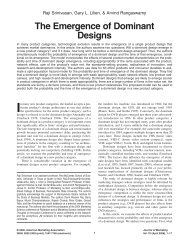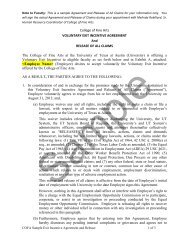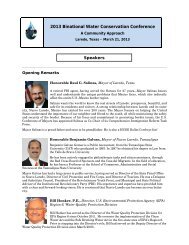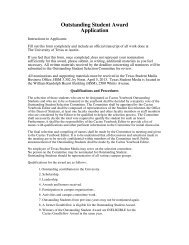Invited Talks: Transition Metal Oxides - University Blog Service - The ...
Invited Talks: Transition Metal Oxides - University Blog Service - The ...
Invited Talks: Transition Metal Oxides - University Blog Service - The ...
Create successful ePaper yourself
Turn your PDF publications into a flip-book with our unique Google optimized e-Paper software.
<strong>The</strong> John B. Goodenough Symposium in Materials Science & Engineering –<br />
In Honor of His 90 th Birthday<br />
<strong>The</strong> <strong>University</strong> of Texas at Austin, Austin, Texas<br />
October 26-27, 2012<br />
High-Voltage Spinel Cathodes for Lithium-Ion Batteries<br />
Katharine Chemelewski, Eun Sung Lee, Zach Moorhead-Rosenberg, Il Tae Kim, and Arumugam Manthiram<br />
Materials Science and Engineering Program, <strong>The</strong> <strong>University</strong> of Texas at Austin<br />
Email: manth@austin.utexas.edu Website: http://www.me.utexas.edu/~manthiram<br />
Abstract Body in Space Below:<br />
(Please use single space, Times New Roman or similar font, size 12, and limit to 250 Words. Please DO NOT exceed the space<br />
below.)<br />
<strong>The</strong> high-voltage spinel cathode LiMn 1.5 Ni 0.5 O 4 is a promising candidate for large-scale energy storage solutions of<br />
the future. With fast, 3D lithium-ion diffusion pathways and a robust crystal structure, this cathode material is well<br />
suited for implementation in vehicle and grid storage applications. However, widespread adoption has been<br />
hampered by capacity fade particularly at elevated temperatures, which has been attributed to many factors<br />
including aggressive solid-electrolyte interphase (SEI) reaction, cation ordering, site defects resulting in the<br />
formation of Mn 3+ , and the orientation of the crystal planes facing the surface. We present here investigations to<br />
develop a fundamental understanding of the factors that govern the electrochemical properties of LiMn 1.5 Ni 0.5 O 4 , as<br />
well as novel techniques to characterize the materials quantitatively and surface modification to suppress unwanted<br />
side reactions. <strong>The</strong> solubility of Ni in LiMn 1.5 Ni 0.5 O 4 is dependent on temperature and increases with decreasing<br />
annealing temperature (e.g., 700 o C), eliminating the Li x Ni 1-x O impurity. Additionally, precursor synthesis<br />
conditions including temperature, pH, stir speed, pressure, and annealing conditions affect the morphology and<br />
electrochemical properties of the final cathode material, and the orientation of the crystal planes facing the<br />
electrolyte interface is a critical factor for stabilizing the cathode during high-voltage operation. Also, it is known<br />
that the performance of the undoped LiMn 1.5 Ni 0.5 O 4 spinel is influenced by the Mn 3+ content, and a magnetic method<br />
has been developed, for the first time, to determine quantitatively the Mn 3+ content that agrees closely with the<br />
electrochemical data. Furthermore, the degree of cation ordering could be compared by examining the lithium<br />
insertion reaction below 3 V into the empty 16c sites, which is consistent with the FTIR and electrochemical data.<br />
Finally, surface modification with graphene and AlPO 4 is shown to improve the cyclability and rate capability of<br />
high-voltage spinel cathodes.
















